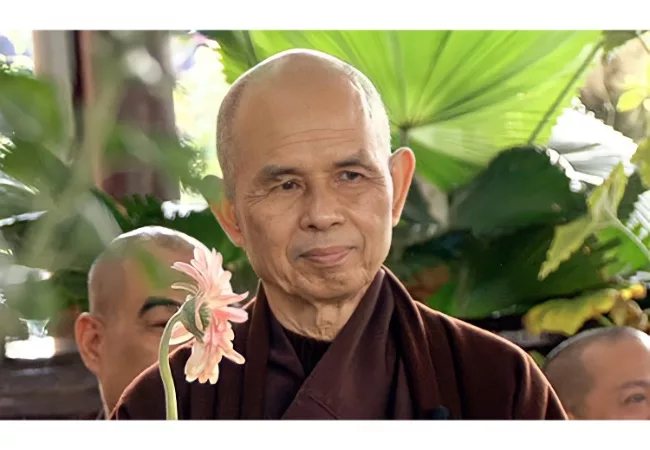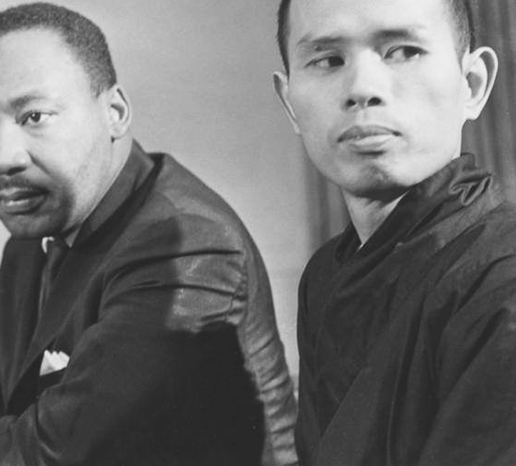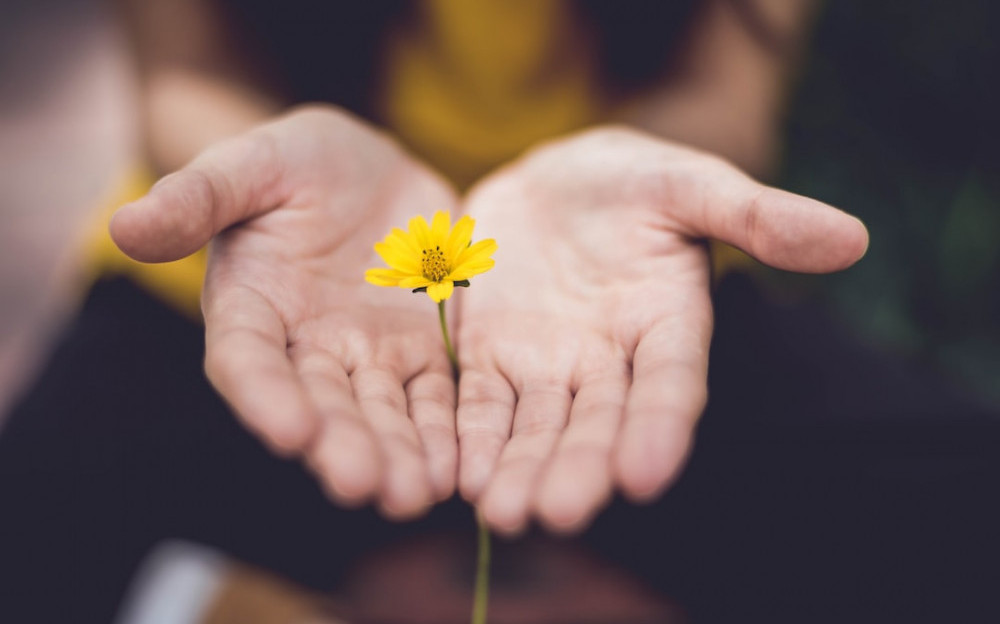Largely how we feel about our life is significantly influenced by our mindsets. The Buddha said that we are caught many times a day by our wrong perceptions. We, therefore, must be cautious and not overly confident in our interpretations.
When we look deeply, we often discover that it is we who cause ourselves the most suffering. The only way to put an end to all of the suffering is never to fix the circumstances but to fix ourselves. In relation to this topic, there is a name that’s really made me have a different look at the Buddhist religion. That is Thich Nhat Hanh. I have come to know about Thich Nhat Hanh through his loving-kindness meditation, which has really helped me a lot in changing my own perceptions to create a happier life.
In this post today, I want to talk about this big figure and the life-changing Thich Nhat Hanh Loving-Kindness Meditation that surely will benefit each of you. So, let’s get started.
So, let’s get started.

Thich Nhat Hanh Loving-Kindness Meditation
Meet the Zen master – Thich Nhat Hanh
Thich Nhat Hanh is no doubt one of the most famous Vietnamese Zen master
He is used to travel widely, spreading the message of peace and brotherhood, sharing messages of peace and unity, urging Western leaders to bring an end to the Vietnam War. Additionally, Thich Nhat Hanh played a leading role in representing Buddhist interests at the Paris Peace Talks in 1969.
Martin Luther King nominated Nhat Hanh for a Nobel Peace Prize. “I do not personally know of anyone more worthy of [the prize] than this gentle monk from Vietnam. His ideas for peace, if applied, would build a monument to ecumenism, to world brotherhood, to humanity,” he wrote.

Thich Nhat Hanh is the founder of the engaged Buddhism movement. He became well-known for his simple yet profoundly deep teachings, guiding his students towards a life of mindfulness, joy, and peace.
Thich Nhat Hanh’s Approach to Loving-Kindness Meditation
Emphasis on mindfulness and presence
The past is gone, the future is not yet here, and if we do not go back to ourselves in the present moment, we cannot be in touch with life.
-Thich Nhat Hanh
One big thing I personally learn from Thich Nhat Hanh is his emphasis on mindfulness and learn to live in the presence. This really made a big impact on my life.
Central to his teachings is the practice of mindfulness meditation, which involves observing our thoughts, emotions, and bodily sensations without judgment.
Thich Nhat Hanh also emphasizes the importance of incorporating mindfulness into every aspect of daily life. This includes practicing mindful eating, where one savors each bite of food and is fully present with the experience of eating.
Whether we are washing dishes, walking in nature, or spending time with loved ones, he encourages us to be fully engaged and aware, rather than allowing our minds to wander to the past or future.
How Loving-Kindness Meditation aligns with the principles of Buddhism
Loving-kindness (also known as “mettā” in Pali) is one of the Four Immeasurables in Buddhism, along with compassion, sympathetic joy, and equanimity.
It is the practice of nurturing boundless, unconditional love and goodwill towards all beings. This involves wishing for the well-being, happiness, and safety of oneself and others without discrimination or limitation, fostering a sense of interconnectedness and unity with all beings.
You can watch Thich Nhat Hanh delivers a profound talk explaining the teachings of love in Buddhism.
The Core Components of Loving-Kindness Meditation
Thich Nhat Hanh loving kindness meditation is not a general mindfulness-awareness practice, loving kindness meditation involves generating specific loving thoughts and emotions. Loving kindness meditation make a beautiful complement to more formless practices like mindfulness-awareness practice.
While the ultimate goal of Thich Nhat Hanh loving-kindness meditation I’m about to introduce here is to generating a sense of interconnectedness and universal love. There are two main different aspects of loving-kindness meditation which are cultivating love, compassion toward yourself and cultivating love,compassion towards others.
Loving- kindness meditation to recognize and accept yourself
A suggestions step by step for loving kindness meditation :
Relax and Center Yourself:
Take a few deep breaths to relax your body and mind. Allow yourself to let go of any tension or stress you may be holding onto.
Set Your Intention:
Set your intention for the practice. This could be something like, “May I recognize and accept myself just as I am.”
Cultivate Mindfulness:
Begin by focusing on your breath. Notice the sensation of the breath as it enters and leaves your body. This helps to anchor your attention in the present moment.
Generate Loving-Kindness Towards Yourself:
Repeat phrases of loving-kindness towards yourself silently or aloud. You can use phrases like:Repeat these phrases slowly and sincerely, allowing the meaning of each phrase to sink in.
- “May I be happy.”
- “May I be healthy.”
- “May I be safe.”
- “May I be at ease.”
Recognize and Accept Yourself:
As you repeat these phrases, bring to mind different aspects of yourself – your strengths, your weaknesses, your successes, your failures. Practice recognizing and accepting each aspect with kindness and compassion.
Remember, the goal is not to change anything about yourself but to accept yourself just as you are in this moment.
End with Gratitude:
Finally, take a moment to express gratitude for yourself and for taking the time to practice loving-kindness meditation.
Notice how you feel after the practice and carry that feeling of acceptance and compassion with you throughout your day.
Tips for loving kindness meditation beginners:
As you begin your loving-kindness meditation journey, it’s best to start by directing love towards yourself first. As you become more comfortable with the imagery and loving phrases, gradually incorporate the visualization of others into your practice. This will become easier and more natural over time. In my opinion, it often feel challenging to love others if you haven’t yet cultivated love for yourself first.
Additionally, focus your loving-kindness meditation on those individuals who are difficult to deal with in your life. This aspect of the meditation can help you forgive them and let go of negative thoughts, bringing you greater peace within.
This is a guided loving kindness meditation guided by Thich Nhat Hanh, you can just listen to this and follow the guidance here:
Extending love and compassion towards others
Relax:
Find a comfortable position to sit or lie down. Take a few deep breaths to relax your body and mind
Set Your Intention:
Decide that you want to send love and compassion to others. You can think of someone specific or just wish for the well-being of all beings.
Generate Loving-Kindness:
Repeat phrases of loving-kindness silently or aloud, such as:
- “May you be happy.”
- “May you be healthy.”
- “May you be safe.”
- “May you be at ease.”
Visualize:
Picture the person or people you’re sending love to in your mind. Imagine them surrounded by warmth and light, filled with happiness and peace.
Expand Your Circle:
Once you feel comfortable, extend your loving-kindness to more people, gradually including loved ones, acquaintances, strangers, and even those you find challenging.
Stay Open:
If you encounter resistance or negative feelings towards certain individuals, acknowledge them without judgment. Remind yourself that everyone deserves love and compassion, including yourself.
Practice Regularly:
Make extending love and compassion towards others a regular practice. The more you do it, the easier it becomes to cultivate feelings of empathy and kindness.
Reflect:
After your practice, take a moment to notice how you feel. Notice any changes in your mood or mindset, and remember to be kind to yourself throughout the process.
Visualize:
Picture the person or people you’re sending love to in your mind. Imagine them surrounded by warmth and light, filled with happiness and peace.
Tips to help you practice loving-kindness meditation towards difficult people whom you need to forgive
Visualize Them as a Whole Person:
Try to see the difficult person as a whole individual, with their own struggles, fears, and vulnerabilities. Recognize that they, like everyone else, are deserving of love and compassion.
Be Patient and Persistent:
Forgiveness and compassion are not always easy to cultivate, especially towards someone who has caused you pain. Be patient with yourself and the process, allow yourself to take a break when it feel overwhelmed.
Benefits of Loving-Kindness Meditation
Psychological benefits
In a study named ” The effect of loving-kindness meditation on employees’ mindfulness, affect, altruism and knowledge hiding” published in BMC Psychol 10, 138 (2022), the effects of the loving-kindness meditation (LKM) on employees’ mindfulness, affect, altruism and knowledge hiding was investigated.
In total, 100 employees were recruited from a knowledge-based enterprise in China and randomly divided into the LKM training group and the control group. The LKM training group underwent LKM training for 8 weeks, while the control group did not.
LKM significantly improved employees’ altruism, and significantly reduce their negative affect. These results further elucidate the psychological effects of LKM and suggest the possibility of reducing knowledge hiding in the workplace.
In another study about the effect of loving kindness meditation on university students found that When the studens tried loving-kindness meditation (LKM) for a short time, it made them feel less anxious and improved their mental health (PMH).
And when researchers checked again later, they found that those who kept doing LKM had less depression, anxiety, and stress. Meanwhile, the group that didn’t do LKM actually had more depression, anxiety, and stress over time.
So, it seems like doing LKM regularly can really help people feel better and less stressed in the long run.
There are many more research study about the effects of loving kindness meditation.
Physical benefits
While most of the research on loving-kindness meditation (LKM) focuses on its psychological and emotional benefits, there’s some evidence to suggest that it may also have physical benefits:
Reduced inflammation:
Chronic stress and negative emotions are associated with increased inflammation in the body, which can contribute to various health problems.
Improved immune function:
Stress can weaken the immune system, making individuals more susceptible to infections and illnesses. LKM has been shown to enhance immune function by reducing stress levels and promoting a positive emotional state, which may help support overall health and well-being.
Pain management:
LKM may help individuals cope with pain by promoting relaxation, reducing stress, and fostering a positive outlook. Some research suggests that LKM practices can be effective in managing chronic pain and improving quality of life for individuals with pain conditions.

Incorporating Loving-Kindness Meditation into Daily Life
Start the day with intention
You may not think that a simple action like setiing the intention for the day could make a big shift on how your day will turn out. Intention will be something that guide you and keep you focused on the important value or goal you want to achieve on that day.

Some examples of setting intentions for the day:
Gratitude: “Today, I intend to notice and appreciate the small moments of joy and gratitude in my life, no matter how busy or challenging the day may be.”
Mindfulness: “My intention for today is to practice mindfulness in everything I do, staying present and fully engaged in each moment, whether it’s eating breakfast, working, or spending time with loved ones.”
Kindness: “I intend to be kind and compassionate towards myself and others today, speaking words of encouragement and offering support wherever I can.”
Productivity: “Today, I intend to focus on my top priorities and tackle my tasks with efficiency and determination, staying organized and avoiding distractions.”
Self-care: “My intention for today is to prioritize my well-being and practice self-care, whether it’s taking breaks when needed, going for a walk outside, or indulging in activities that nourish my body and soul.”
Intergrate mindfulness into daily activities
Mindful breathing:
Take a few moments to focus on your breath throughout the day. Notice the sensation of the air entering and leaving your nostrils or the rise and fall of your chest and abdomen. Whenever you feel stressed or overwhelmed, pause and take a few deep breaths to center yourself.
Mindful eating:
Slow down and savor each bite of your meals. Pay attention to the colors, textures, flavors, and smells of the food. Chew slowly and mindfully, noticing the sensations in your mouth and the feeling of nourishment as you eat.
Avoid distractions such as TV or electronic devices while eating.

Mindful walking:
Take a walk outside and pay attention to your surroundings. Notice the sights, sounds, and sensations of walking—the feeling of your feet making contact with the ground, the breeze on your skin, the sounds of nature or city life around you.
You can also practice mindful walking indoors by paying attention to each step as you move around your home or workplace. Check out my post about gratitude waking here.
Mindful daily tasks:
Approach everyday activities such as washing dishes, doing laundry, or brushing your teeth with mindfulness. Focus on the sensations, movements, and rhythm of the task at hand. Engage all your senses and bring awareness to each moment without getting lost in thoughts about the past or future.
Thich Nhat Hanh often used the example of washing dishes as a metaphor for mindfulness practice. He emphasized the importance of being fully present and engaged in every moment, even in seemingly mundane activities like washing dishes.
“When I wash the dishes, I will wash the dishes. When I am drinking tea, I will drink tea. When I am walking, I will walk. When I am sitting, I will sit. When I am breathing, I will breathe.”
Thich Nhat Hanh
Final Words
As Thich Nhat Hanh said “Waking up this morning, I smile. Twenty-four brand new hours are before me. I vow to live fully in each moment and to look at all beings with eyes of compassion.”
In a world where kindness can sometimes feel scarce, these suggested Thich Nhat Hanh loving kindness meditation can truly make a big difference. I think these meditations help to open the door to a world where compassion reigns supreme, filling our hearts with warmth and our minds with clarity.
I hope you will start approach each day with a sense of gratitude and openness, fully embracing the present moment and extending compassion to all beings.







Hi Lily, this is such a nice article that gives us great insight into meditation. In this world full of distractions people need something like the Loving-Kindness Meditation. I know I can certainly benefit from it. We are forgetting how it is to be present in the moment with everything that is surrounding us. Mindfulness is more rare than ever, at least I see it like that. Thank you for introducing me to something that can improve my quality of life. I have tried meditation in the past, but it was short-lived. I like the LKM concept and I am going to give it a go.
Dan
Hi Dan,
It’s understandable that previous attempts at meditation may have been short-lived, but I’m glad to hear that you’re open to giving the LKM concept a try.
Meditation is a practice, and it’s okay if it takes time to find what works best for you.
I’m here to support you on your journey towards greater mindfulness and well-being.
Warm regards,